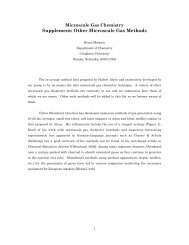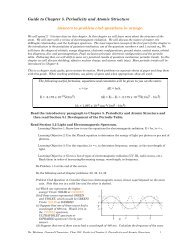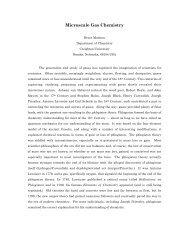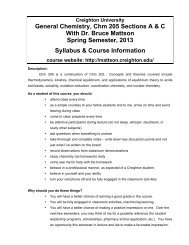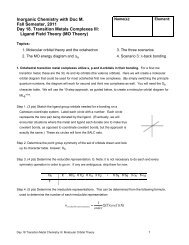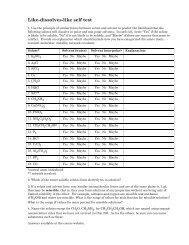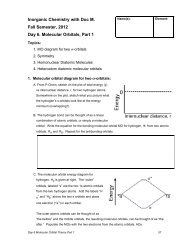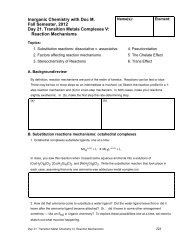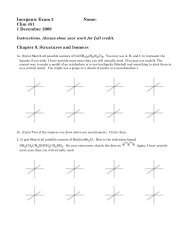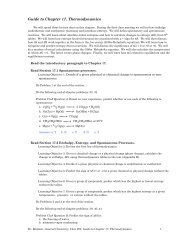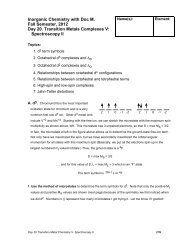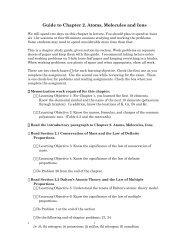Guide to Chapter 10. Liquids and Solids Answers in red - Mattson
Guide to Chapter 10. Liquids and Solids Answers in red - Mattson
Guide to Chapter 10. Liquids and Solids Answers in red - Mattson
Create successful ePaper yourself
Turn your PDF publications into a flip-book with our unique Google optimized e-Paper software.
<strong>Guide</strong> <strong>to</strong> <strong>Chapter</strong> <strong>10.</strong> <strong>Liquids</strong> <strong>and</strong> <strong>Solids</strong><br />
We will spend three lecture days on this chapter.<br />
<strong>Answers</strong> <strong>in</strong> <strong>red</strong><br />
Read the <strong>in</strong>troduc<strong>to</strong>ry paragraph <strong>to</strong> <strong>Chapter</strong> <strong>10.</strong><br />
Read Section <strong>10.</strong>1 Polar Covalent Bonds <strong>and</strong> Dipole Moments.<br />
Learn<strong>in</strong>g Objective 1: Given the formula of a molecular compound determ<strong>in</strong>e if it is polar or non polar<br />
covalent.<br />
Learn<strong>in</strong>g Objective 2: Know the def<strong>in</strong>ition of STP. Know the st<strong>and</strong>ard molar volume (22.4 L)<br />
Do Problems 1 - 4 at the end of the section.<br />
Do the follow<strong>in</strong>g end-of-chapter problems: 22, 30, 36, 38<br />
Read Section <strong>10.</strong>2 Intermolecular Forces <strong>and</strong> Section <strong>10.</strong>3 Some Properties of <strong>Liquids</strong><br />
Learn<strong>in</strong>g Objective 3: Given the formula of a compound, determ<strong>in</strong>e the major attractive force. (ionic =<br />
ion-ion <strong>and</strong> ion-dipole) <strong>and</strong> (molecular <strong>and</strong> covalent = dipole-dipole, hydrogen bond<strong>in</strong>g, or London<br />
dispersion forces.<br />
Learn<strong>in</strong>g Objective 4: Given a list of compound formulas rank their attractive forces <strong>in</strong> order of<br />
strength.<br />
Learn<strong>in</strong>g Objective 5: Describe the relationship between size <strong>and</strong> strength of London dispersion forces.<br />
Learn<strong>in</strong>g Objective 6: Describe the relationship between size <strong>and</strong> strength of London dispersion forces.<br />
Do Problems 5 <strong>and</strong> 6 at the end of Section <strong>10.</strong>2.<br />
Do the follow<strong>in</strong>g end-of-chapter problems: 32, 34, 40<br />
Problem Club Question A. (a) Create a graph (general appearance only) with MM on the x-axis <strong>and</strong> boil<strong>in</strong>g<br />
po<strong>in</strong>ts on the y-axis for these similar compounds: NH3, PH3, AsH3, <strong>and</strong> SbH3 (b) Repeat for CH4, SiH4,<br />
GeH4, <strong>and</strong> SnH4<br />
Answer: boil<strong>in</strong>g po<strong>in</strong>ts ( o C): (a) NH3 = -33, PH3 = -87, AsH3 = -55, SbH3 -17 (b) CH4 = -164,<br />
SiH4 = -111, GeH4 -89, <strong>and</strong> SnH4 = -52<br />
Problem Club Question B. Why is iod<strong>in</strong>e a solid?<br />
Answer: very substantial London-dispersion forces due <strong>to</strong> the large MM<br />
Problem Club Question C. Circle the chemical with the highest melt<strong>in</strong>g po<strong>in</strong>t:<br />
<strong>Answers</strong> <strong>in</strong> <strong>red</strong><br />
(a) F2 or Cl2 (b) F2 or FCl (c) Cl2 or FCl<br />
(d) NaCl or Cl2 (e) HF or HBr (f) CH3CH2CH3 or CH3CH2CH2OH<br />
Problem Club Question D. True or False:<br />
<strong>Answers</strong> <strong>in</strong> <strong>red</strong><br />
T F Covalent bonds are weaker than London-dispersion forces<br />
T F Dipole forces are stronger than London-dispersion forces<br />
T F Only non-polar molecules have London-diispersion forces<br />
T F CaS <strong>and</strong> KCl have similar MMs, however CaS should have a much larger mp.<br />
T F The heat of vaporization <strong>in</strong>creases with MM for the series (BH2)n<br />
Dr. <strong>Mattson</strong>, General Chemistry, Chm 203, <strong>Guide</strong> <strong>to</strong> <strong>Chapter</strong> <strong>10.</strong> <strong>Liquids</strong> <strong>and</strong> <strong>Solids</strong> 1
(<br />
Problem Club Question E. Which exhibits hydrogen bond<strong>in</strong>g <strong>in</strong> the liquid<br />
form? (Central a<strong>to</strong>m underl<strong>in</strong>ed where necessary)<br />
(a) H2O (b) HI (c) HBr<br />
(d) CH3OH (e) N(CH3)3 (f) CH3OCH3<br />
(g) HCHO (h) CH3COOH (shown at right)<br />
Read Section <strong>10.</strong>4 Phase Changes.<br />
Learn<strong>in</strong>g Objective 7: Given a set of compounds, p<strong>red</strong>ict their relative orders of boil<strong>in</strong>g po<strong>in</strong>t, melt<strong>in</strong>g<br />
po<strong>in</strong>t, DHvap, DHfus, or vapor pressure.<br />
Learn<strong>in</strong>g Objective 8: Know the physical properties of liquids <strong>in</strong> terms of their<br />
a. vapor pressure b. evaporation/condensation c. normal boil<strong>in</strong>g po<strong>in</strong>t<br />
d. sublimation e. surface tension f. viscosity<br />
g. cohesive, adhesive forces h. melt<strong>in</strong>g freez<strong>in</strong>g<br />
Learn<strong>in</strong>g Objective 9: Expla<strong>in</strong> how each of the follow<strong>in</strong>g parameters affect the rate of evaporation of a<br />
liquid. a. <strong>in</strong>termolecular forces b. temperature c. surface area<br />
Do Problems 7 <strong>and</strong> 8 at the end of the section.<br />
Do the follow<strong>in</strong>g end-of-chapter problems: 42, 44, 46, 48, 50, 52<br />
Problem Club Question F. (ACS-Style) Answer: C<br />
Problem Club Question G. (ACS-Style) Answer: C<br />
Read Section <strong>10.</strong>5. Evaporation, Vapor pressure <strong>and</strong> Boil<strong>in</strong>g Po<strong>in</strong>t. Read this section for<br />
qualitative underst<strong>and</strong><strong>in</strong>g. We will not use the Clausius-Clapeyron Equation, but will spend time with<br />
Figures <strong>10.</strong>12 <strong>and</strong> <strong>10.</strong>13.<br />
Learn<strong>in</strong>g Objective 10: Expla<strong>in</strong> how the pressure above a liquid affects the bp of a liquid.<br />
Learn<strong>in</strong>g Objective 11: Expla<strong>in</strong> the relationship between the vapor pressure of a liquid <strong>and</strong> the<br />
temperature.<br />
Learn<strong>in</strong>g Objective 12: What is the sign of the amount of heat energy, q, needed for<br />
evaporation/condensation <strong>and</strong> melt<strong>in</strong>g/freez<strong>in</strong>g?<br />
Learn<strong>in</strong>g Objective 13: Write simple chemical equations show<strong>in</strong>g the "equilibrium" occurr<strong>in</strong>g dur<strong>in</strong>g a<br />
change of state.<br />
Learn<strong>in</strong>g Objective 14: Phase change calculations:<br />
a. Given the amount of a substance <strong>and</strong> its DHfus determ<strong>in</strong>e the quantity of heat, q, needed <strong>to</strong> melt the<br />
solid or freeze the liquid. Watch the sign of this determ<strong>in</strong>ed amount of heat energy!<br />
b. Given the amount of a substance <strong>and</strong> its DHvap, determ<strong>in</strong>e the quantity of heat, q, needed <strong>to</strong> boil the<br />
liquid or condense the gas. Pay attention <strong>to</strong> the sign of this determ<strong>in</strong>ed amount of heat energy.<br />
c. Sketch a heat<strong>in</strong>g or cool<strong>in</strong>g curve show<strong>in</strong>g the plot of temperature vs. q for a given substance from<br />
the solid state <strong>to</strong> the gas state or from gas <strong>to</strong> solid. You will be given the bp <strong>and</strong> mp <strong>in</strong> order <strong>to</strong> do<br />
this.<br />
Problem Club Question H. How much heat is imparted <strong>to</strong> your h<strong>and</strong> when you hold it <strong>in</strong> steam at 100 o C<br />
<strong>and</strong> 3.0 g of steam condenses <strong>to</strong> liquid water at 100 o C? [DHvap = + 40.7 kJ/mol]<br />
Answer: 6.8 kJ<br />
Problem Club Question I. How much heat is taken from your <strong>to</strong>ngue when you melt a 10-g ice cube at 0 o C<br />
<strong>to</strong> form water at 0 o C? [DHfus = + 6.0 kJ/mol]<br />
H O<br />
C C<br />
H<br />
Dr. <strong>Mattson</strong>, General Chemistry, Chm 203, <strong>Guide</strong> <strong>to</strong> <strong>Chapter</strong> <strong>10.</strong> <strong>Liquids</strong> <strong>and</strong> <strong>Solids</strong> 2<br />
H<br />
O<br />
H
Answer: 3.3 kJ<br />
Problem Club Question J. Ethanol has a normal boil<strong>in</strong>g po<strong>in</strong>t that is 80 o C. Plot the equilibrium vapor<br />
pressure for ethanol (y-axis) aga<strong>in</strong>st the temperature (x-axis)<br />
Answer: Should appear <strong>to</strong> the left of the l<strong>in</strong>e for water.<br />
Problem Club Question K. How much heat it would take <strong>to</strong> vaporize 250 mL of water at 19 o C <strong>to</strong> steam at<br />
100 o C? (You will need <strong>to</strong> look up a few constants from the textbook.)<br />
Answer: +650 kJ<br />
Problem Club Question L. (ACS-Style) Answer: A<br />
Problem Club Question M. (ACS-Style) Answer: C<br />
Problem Club Question N. (ACS-Style) Answer: A<br />
Problem Club Question O. (ACS-Style) Answer: A<br />
Problem Club Question P. (ACS-Style) Answer: D<br />
Problem Club Question Q. (ACS-Style) Answer: A<br />
Problem Club Question R. (ACS-Style) Answer: D<br />
Read Section <strong>10.</strong>6. K<strong>in</strong>ds of <strong>Solids</strong><br />
Learn<strong>in</strong>g Objective 15: Given the formula of a compound, p<strong>red</strong>ict the type of solid it will form. The<br />
possible types of solids <strong>in</strong>clude network covalent, ionic, molecular, or metallic.<br />
Learn<strong>in</strong>g Objective 16: Given the physical properties of an unknown solid, p<strong>red</strong>ict the type of solid.<br />
Do the follow<strong>in</strong>g end-of-chapter problems: 66<br />
Problem Club Question S. Carbon dioxide crystallizes <strong>in</strong> one of the cubic cells we have studied. There are<br />
four CO2 molecules per unit cell. (a) What unit cell is used by CO2? (b) How many oxygen a<strong>to</strong>ms are<br />
there per unit cell?<br />
Answer: (a) fcc (b) eight<br />
Skip Section <strong>10.</strong>7.<br />
Read Section <strong>10.</strong>8. Unit Cells <strong>and</strong> the Pack<strong>in</strong>g of Spheres <strong>in</strong> Crystall<strong>in</strong>e <strong>Solids</strong> <strong>and</strong> <strong>10.</strong>9<br />
Structures of Some Ionic <strong>Solids</strong><br />
Learn<strong>in</strong>g Objective 17: Given a sketch crystall<strong>in</strong>e unit cell, determ<strong>in</strong>e the number of a<strong>to</strong>ms or ions that<br />
are present <strong>in</strong> the unit cell.<br />
Learn<strong>in</strong>g Objective 18: Given a sketch crystall<strong>in</strong>e unit cell, determ<strong>in</strong>e the number of formula units<br />
with<strong>in</strong> the unit cell <strong>and</strong> the empirical formula of the compound.<br />
Do Problems 11 – 13 at the end of Section <strong>10.</strong>8 <strong>and</strong> Problems 15 <strong>and</strong> 16 at the end of Section <strong>10.</strong>9.<br />
Do the follow<strong>in</strong>g end-of-chapter problems: 24, 25, 82, 84, 86, 90, 92<br />
Problem Club Question T. Polonium is the only metal known <strong>to</strong> crystallize <strong>in</strong> the simple cubic cell<br />
arrangement. How many Po a<strong>to</strong>ms are there per unit cell?<br />
Answer: one<br />
Problem Club Question U. What is the volume of a fcc unit cell <strong>in</strong> which the a<strong>to</strong>ms have a radius of 1.49 x<br />
10 -8 cm? Express this value <strong>in</strong> pm 3<br />
Answer: 7.49 x 10 -23 cm 3 or (b) 7.49 x 10 7 pm 3<br />
Dr. <strong>Mattson</strong>, General Chemistry, Chm 203, <strong>Guide</strong> <strong>to</strong> <strong>Chapter</strong> <strong>10.</strong> <strong>Liquids</strong> <strong>and</strong> <strong>Solids</strong> 3
Problem Club Question V. Refer <strong>to</strong> the volume you calculated for the fcc unit cell <strong>in</strong> the previous problem.<br />
(a) How many a<strong>to</strong>ms are there per unit cell for the fcc unit cell? (b) If these were gold a<strong>to</strong>ms, what is the<br />
mass of these a<strong>to</strong>ms? (You need <strong>to</strong> use Avogodro’s number, 6.02 x 10 23 ) (c) What is the formula for<br />
density? (d) What is the density of this substance?<br />
Answer: (a) four (b) 1.31 x 10 -21 g (c) density = m/V (d) 17.5 g/cm 3<br />
Problem Club Question W. A crystall<strong>in</strong>e compound conta<strong>in</strong>s X anions <strong>and</strong> Y cations <strong>in</strong> a cubic lattice. If<br />
each unit cell conta<strong>in</strong>s X anions at the corners <strong>and</strong> at the face centers <strong>and</strong> Y cations at the body center,<br />
what is the formula of the compound?<br />
Answer: YX4<br />
Problem Club Question X. (ACS-Style) Answer: C<br />
Problem Club Question Y. (ACS-Style) Answer: B<br />
Problem Club Question Z. (ACS-Style Answer: C<br />
Problem Club Question AA. (ACS-Style) Answer: C<br />
Read Section <strong>10.</strong><strong>10.</strong> Structures of Some Covalent Network <strong>Solids</strong>.<br />
Problem Club Question BB. (ACS-Style) Answer: A<br />
Read Section <strong>10.</strong>11 Phase Diagrams.<br />
Learn<strong>in</strong>g Objective 19: Given a phase diagram, locate or def<strong>in</strong>e the follow<strong>in</strong>g terms with an<br />
"equilibrium equation:<br />
a. condensation b. evaporation c. sublimation<br />
d. super cooled liquid e. triple po<strong>in</strong>t f. normal bp <strong>and</strong> freez<strong>in</strong>g po<strong>in</strong>t<br />
g. critical po<strong>in</strong>t h. equilibrium i. critical temperature, critical pressure<br />
Learn<strong>in</strong>g Objective 20: Identify the parts of a given phase diagram: melt<strong>in</strong>g curve, vapor curve,<br />
sublimation curve, triple po<strong>in</strong>t, <strong>and</strong> critical po<strong>in</strong>t, etc.<br />
Learn<strong>in</strong>g Objective 21: Given a phase diagram, determ<strong>in</strong>e the phase (s, l, g, etc.) at a given temperature<br />
<strong>and</strong> pressure.<br />
Learn<strong>in</strong>g Objective 22: At a given pressure, determ<strong>in</strong>e the changes of phase that occur when the<br />
temperature is changed.<br />
Learn<strong>in</strong>g Objective 23: At a given temperature, determ<strong>in</strong>e the changes of phase that occur when the<br />
pressure is changed.<br />
Learn<strong>in</strong>g Objective 24: Given <strong>in</strong>formation such as the triple po<strong>in</strong>t, normal bp <strong>and</strong> normal mp,<br />
qualitatively construct a rough phase diagram <strong>and</strong> answer question concern<strong>in</strong>g the substance.<br />
Do Problems 17 <strong>and</strong> 18 at the end of the section.<br />
Do the follow<strong>in</strong>g end-of-chapter problems: 26<br />
Problem Club Question CC. Refer <strong>to</strong> the phase diagram for CO2 discussed <strong>in</strong> class. Sketch it <strong>and</strong> label all<br />
parts; (b) What is the phase of CO2 at O o C <strong>and</strong> 1 atm pressure? (c) Referr<strong>in</strong>g <strong>to</strong> the conditions <strong>in</strong> (b),<br />
would it be possible <strong>to</strong> change phases without chang<strong>in</strong>g temperature? If so, what phase change would<br />
this be? (d) Suppose your tank of CO2 is s<strong>to</strong><strong>red</strong> <strong>in</strong> a room that is at 100 o F Is CO2 a permanent or<br />
condensable gas? (e) The blade of an ice skate causes a huge <strong>in</strong>crease <strong>in</strong> pressure <strong>to</strong> the ice as the blade<br />
passes overhead. What occurs <strong>in</strong> terms of the phase diagram for water? (f) What phase of H2O is present<br />
at 800 mmHg <strong>and</strong> -20 o C? What phase transition occurs (if any) when the H2O is warmed <strong>to</strong> 50 o C?<br />
What would have happened if the pressure were decreased <strong>to</strong> 700 mmHg <strong>in</strong>stead of <strong>in</strong>creas<strong>in</strong>g the<br />
temperature?<br />
Dr. <strong>Mattson</strong>, General Chemistry, Chm 203, <strong>Guide</strong> <strong>to</strong> <strong>Chapter</strong> <strong>10.</strong> <strong>Liquids</strong> <strong>and</strong> <strong>Solids</strong> 4
Answer: (b) gas (c) Yes, <strong>in</strong>creas<strong>in</strong>g the pressure <strong>to</strong> form a liquid (d) permanent gas (e) water melts<br />
under tremendous pressure (f) solid, melts, noth<strong>in</strong>g.<br />
Problem Club Question DD. (ACS-Style) Answer: D<br />
Problem Club Question EE. (ACS-Style) Answer: B<br />
Problem Club Question FF. (ACS-Style) Answer: B<br />
Problem Club Question GG. (ACS-Style) Answer: C<br />
Problem Club Question HH. (ACS-Style) Answer: C<br />
Dr. <strong>Mattson</strong>, General Chemistry, Chm 203, <strong>Guide</strong> <strong>to</strong> <strong>Chapter</strong> <strong>10.</strong> <strong>Liquids</strong> <strong>and</strong> <strong>Solids</strong> 5



